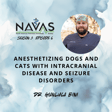
Dr. Erik Hofmeister on Discussing Anesthetic Risk with Clients
Anesthesia is a vital part of veterinary care—it’s what makes lifesaving and life-improving procedures possible for our patients. But for many pet owners, the thought of anesthesia can be downright nerve-wracking. From easing general worries and tackling tough cost conversations to navigating the emotional challenges of unexpected complications, one thing is clear: compassionate, honest communication makes all the difference.
In this episode of the North American Veterinary Anesthesia Society (NAVAS) Podcast, host Dr. Bonnie Gatson is joined by returning guest and communication pro Dr. Erik Hofmeister to explore the do’s, don’ts, and definitely-don’t-say-thats of discussing anesthetic risk with clients. From setting expectations to managing risk-averse pet parents, and navigating the emotional terrain of adverse events, we’re covering it all—with plenty of practical tips along the way. Whether you feel like a seasoned orator or you're just trying to survive conversations without sweating through your scrubs, this episode is sure to provide helpful pointers for communicating effectively about anesthesia to your clients with confidence, clarity, and compassion.
If you like what you hear, we have a couple of favors to ask of you:
Become a member of NAVAS for access to more anesthesia and analgesia educational and RACE-approved CE content. The NAVAS Virtual Spring Symposium will be held on May 3-4, 2025. Registration for the event is open now.
Spread the word. Share our podcast on your socials or a discussion forum. That would really help us achieve our mission: Reduce mortality and morbidity in veterinary patients undergoing sedation, anesthesia, and analgesia through high-quality, peer-reviewed education.
Thank you to our sponsor, Dechra - learn more about the pharmaceutical products Dechra has to offer veterinary professionals, such as Zenalpha.
If you have questions about this episode or want to suggest topics for future episodes, reach out to the producers at education@mynavas.org.
All opinions stated by the host and their guests are theirs alone and do not represent the thoughts or opinions of any corporation, university, or other business or governmental entity.










